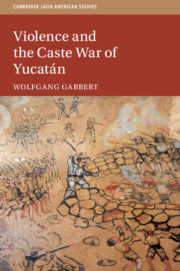Book contents
- Violence and the Caste War of Yucatán
- Cambridge Latin American Studies
- Violence and the Caste War of Yucatán
- Copyright page
- Dedication
- Contents
- Illustrations
- Acknowledgments
- Introduction: Caste War Violence – Prospect and State of the Art
- Part I Violence and War
- Part II Violence in Yucatán Before and Beyond the Caste War, 1821–1901
- Part III The Caste War and Violence: An Overview
- Part IV Violence and the Government Forces
- Part V Violence and the Kruso’b
- Part VI Intricacies of Caste War Violence
- Appendices
- Bibliography
- Index
- Other Books in the Series (continued from page ii)
Part V - Violence and the Kruso’b
Published online by Cambridge University Press: 09 August 2019
- Violence and the Caste War of Yucatán
- Cambridge Latin American Studies
- Violence and the Caste War of Yucatán
- Copyright page
- Dedication
- Contents
- Illustrations
- Acknowledgments
- Introduction: Caste War Violence – Prospect and State of the Art
- Part I Violence and War
- Part II Violence in Yucatán Before and Beyond the Caste War, 1821–1901
- Part III The Caste War and Violence: An Overview
- Part IV Violence and the Government Forces
- Part V Violence and the Kruso’b
- Part VI Intricacies of Caste War Violence
- Appendices
- Bibliography
- Index
- Other Books in the Series (continued from page ii)
Summary
Warfare is not only about exerting military force but also about logistics. Men need arms to fight efficiently and, above all, they have to eat. Thus to a significant degree the struggle for survival and foodstuffs determined the Caste War during its first two decades. Although government forces often suffered as a result of insufficient supplies, they could at least rely on existing structures of production, distribution and transport, such as haciendas, trades and roads. The Caste War rebels, on the other hand, had to create their own economic system from scratch. While insurgents were mostly in a position to live “off the country,” commandeering or plundering the required resources in the areas under their control during the first year of the conflict, provisioning combatants and their families became more trying after their withdrawal to the eastern and southeastern parts of the peninsula. Firearms, powder, lead and other desired items had to be procured either by looting in the government-controlled area or purchasing them in Belize.
- Type
- Chapter
- Information
- Violence and the Caste War of Yucatán , pp. 147 - 151Publisher: Cambridge University PressPrint publication year: 2019

